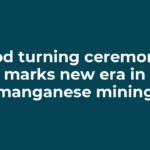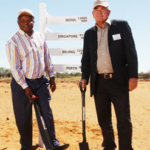End of the beginning
Empowerment group Safika Holdings feared for a while in 2001 it had missed out on the mining boom.
“We searched around for the commodity that everyone else had overlooked,” says Safika chairman Saki Macozoma. “We found manganese.”
Safika’s 10-year pursuit of manganese, a key input into steel, brought it to the point where it could turn its first sod last week at the Tshipi Borwa mine near Kathu in the Northern Cape.
Macozoma and his partner in Safika, Moss Ngoasheng, are well known in SA’s business community: Macozoma is a former MD of Transnet and now chairman of Stanlib and Liberty Life, as well as deputy chairman of Standard Bank. Ngoasheng, a former economic adviser to the ANC, chairs the Coega Development Corp and Kelly Group. Each owns just over 20% of Safika, with Standard Bank owning another 20%. The latest net asset value estimate for Safika is about R2,5bn, Macozoma says.
Their connections in the business community will underpin the success of the Tshipi Borwa mine, which depends on Transnet to rail its projected 2,4Mt/year of manganese to port. SA’s exports of manganese, now through Port Elizabeth, are likely to move to a planned new terminal at Coega .
Safika is the majority shareholder in an empowerment consortium, Ntsimbintle Mining, in which Asian manganese group OM Holdings and the local community also have stakes. Ntsimbintle, in turn, is the majority shareholder in Tshipi é Ntle, the owner of the mine. Brian Gilbertson’s ASX-listed Jupiter Mining owns a 49,9% stake in Tshipi é Ntle. Macozoma is chairman of Tshipi é Ntle and Ntsimbintle.
The Tshipi Borwa deposit is on ground released by Samancor Manganese, adjacent to its Mamatwan Mine, under the changed mining dispensation introduced by the Minerals & Petroleum Resources Development Act in 2004. Tshipi Borwa’s manganese resource is similar to Mamatwan’s. According to Tshipi Borwa GM Mogkosi Nkoana, the deposit starts 70m from surface and extends to a depth of 350m. Based on current information, the mine will have a 60-year life.
But finding an economically viable deposit of manganese was only the starting point. “Empowerment has attracted a bad name because of projects where black people got the prospecting rights and just sold them on,” Macozoma says.
“In our negotiations with Samancor Manganese, we didn’t know at first where we were going to go. With our partners [Pallinghurst Co-Investors, which owns a majority stake in Jupiter Mining] we completed a bankable feasibility study. That brought in some money from our earn-in, but it was not enough to provide half the funding to build the mine. I knew we would not be able to borrow as much as we needed.”
When Ntsimbintle’s representatives attended the annual International Manganese Conference in Dubai, they met Singaporean group OM Holdings, the owner of a manganese mine in Australia and a smelter in China, for which they needed manganese. OM Holdings took an equity stake in Ntsimbintle and ensured the entity had access to funding.
“It has taken persistence and a sustained effort ,” says Macozoma.
Though it is not a well-known player in the mining sector, over the years Safika has made other, smaller investments in established mining or mining services groups. These include stakes in alluvial diamond mining, in listed cement and fluorspar company Sephaku Holdings and in independent coal transport group Oosthuizens, in which Safika holds 70%.
Though Macozoma says there are no plans to list Safika, there could be potential to list Oosthuizens in some form in future.
Safika continues to look for investment opportunities in the steelmaking sector, such as an iron-ore property it is exploring. “We are opportunistic,” Macozoma says. “We have the balance sheet, financial muscle and expertise to make acquisitions.”
Charlotte Mathews

